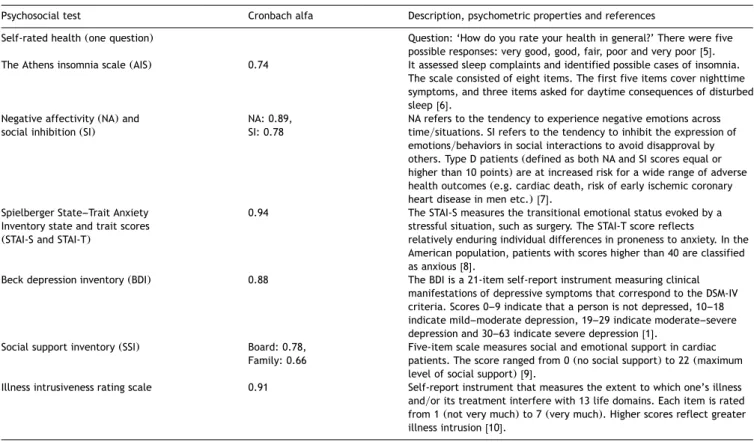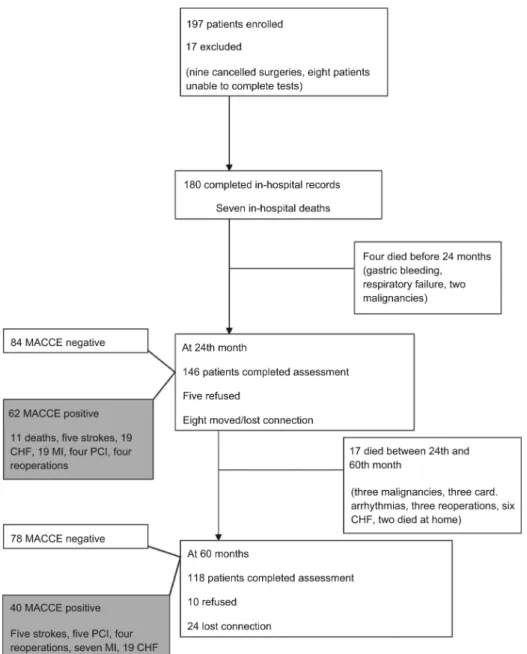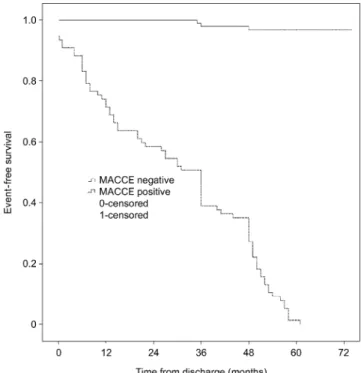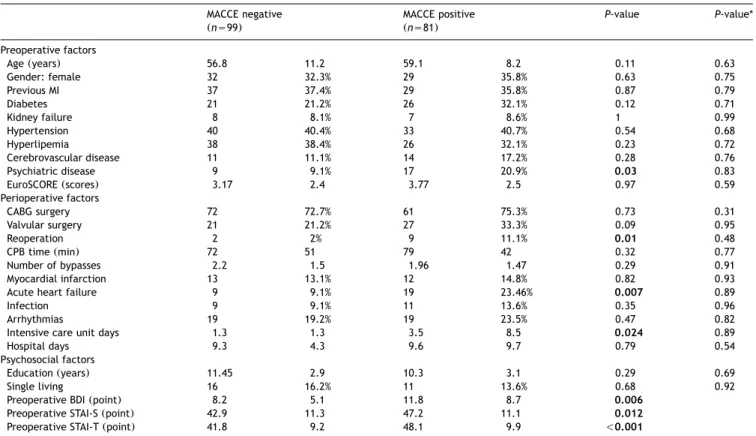www.icvts.org Interactive CardioVascular and Thoracic Surgery 11 (2010) 567–572
䊚2010 Published by European Association for Cardio-Thoracic Surgery
NewIdeas InstitutionalReport WorkinProgressReport ESCVSArticle NegativeResults State-of-the-art BestEvidenceTopic BriefCommunication CaseReportFollow-upPaper Protocol ProposalforBail-outProcedureNomenclature HistoricalPages
Institutional report - Cardiopulmonary bypass
Psychosocial factors and major adverse cardiac and cerebrovascular events after cardiac surgery 夞
Zsuzsanna Csere´p , Piroska Balog , Judit Szea b ´kely , Andrac ´s Treszl , Mad ´ria S. Kopp , Julian F. Thayer ,b e Andrea Sze´kelya,f,*
Department of Anaesthesiology and Intensive Care, Semmelweis University, Budapest, Hungary
a
Institute of Behavioural Sciences, Semmelweis University, Budapest, Hungary
b
Department of Radiotherapy, National Institute of Oncology, Budapest, Hungary
c
First Department of Pediatrics, Semmelweis University, Budapest, Hungary
d
Department of Psychology, The Ohio State University, Columbus, USA
e
Department of Anaesthesia and Intensive Care, Gottsegen Gyo¨rgy Hungarian Institute of Cardiology, Haller u. 29, H-1096 Budapest, Hungary
f
Received 5 June 2010; received in revised form 3 August 2010; accepted 5 August 2010 Abstract
Our aim was to prospectively examine the association of psychosocial factors with adverse outcome after cardiac surgery. One hundred and eighty cardiac surgery patients were enrolled and contacted annually by mail. DepressionwBeck depression inventory(BDI)x, anxiety wstate anxiety subscale in Spielberger State–Trait Anxiety Inventory(STAI-S)and trait anxiety subscale in Spielberger State–Trait Anxiety Inventory (STAI-T)x were investigated annually, social support, negative affectivity, social inhibition(SI), illness intrusiveness, self-rated health and sleeping disorders were investigated by standardized tests at the second and fifth year. The end-point was the major adverse cardiac and cerebrovascular event(MACCE)including death. Twenty-eight(15.5%)patients died by the end of the fifth year. At the end of the second and fifth years, 146 (81.1%) and 118(65.5%)patients fulfilled the tests, respectively. At the end of the second year after adjustment for medical and perioperative factors worse self-rated healthwadjusted hazard ratio(AHR): 0.67,Ps0.006x, sleeping disorders (AHR: 1.14,Ps0.001), higher illness intrusiveness(AHR: 1.03,Ps0.018), higher BDI(AHR: 1.12,Ps0.001), STAI-S(AHR: 1.09,Ps0.001) and higher STAI-T scores(AHR: 1.08,Ps0.002)showed higher risk for MACCE. Significant individual elevation in scores of sleeping disorders, illness intrusiveness and SI were observed over the three-year period in the MACCE group. Assessment of psychosocial factors could help in identifying patients at high-risk for MACCE after cardiac surgery.
䊚2010 Published by European Association for Cardio-Thoracic Surgery. All rights reserved.
Keywords: Anxiety; Depression; Stroke; Outcomes; Reoperation
1. Introduction
Over the last three decades, researchers have recognized the unique impact of psychosocial factors, such as anxiety, depression, social support, and self-rated health on the recovery from medical procedures regarding coronary heart disease w1x. Psychiatric co-morbidity increases the risk of adverse outcomes in myocardial infarction (MI), such as worse prognosis, high medical costs, and higher mortality ratew2x.
The majority of prior investigations have focused on predictors of in-hospital morbidity and complications. Since mortality has become relatively low after cardiac surgery, the effectiveness of the operation has been assessed by the measurement of patients’ well-being and quality of life w2x. Thus, the aim of the present study was to investigate
夞This study was supported by grants from the Hungarian Research Foun- dation(OTKA-T-035169), Budapest, Hungary, and by National Research and Development Programs(NKFP 1by020y2004), Budapest, Hungary.
*Corresponding author. Tel.:q36-1-2151-220; fax:q36-1-2157-096.
E-mail address:szekelya@kardio.hu(A. Sze´kely).
the influence of psychological factors beyond clinical risk factors and perioperative characteristics on the five-year occurrence of major adverse cardiac and cerebrovascular event(MACCE)and death.
2. Materials and methods
2.1. Study population
The study population comprised of 197 patients admitted for elective coronary artery bypass grafting(CABG)or valve surgery at the Gottsegen Hungarian Institute of Cardiology, between July 2000 and May 2001. There was no eligibility restriction in terms of age, gender, or cardiac condition and no classification of on- and off-pump procedures. All patients signed the informed consent. The participants were not managed differently than the other patients, e.g.
there was no psychosocial preparation, it was an observa- tive study.
The baseline questionnaires were completed one to five days before surgery. Of the 197, 17 patients were excluded
Table 1. Applied psychosocial tests and Cronbach alfa for study population
Psychosocial test Cronbach alfa Description, psychometric properties and references
Self-rated health(one question) Question: ‘How do you rate your health in general?’ There were five possible responses: very good, good, fair, poor and very poorw5x.
The Athens insomnia scale(AIS) 0.74 It assessed sleep complaints and identified possible cases of insomnia.
The scale consisted of eight items. The first five items cover nighttime symptoms, and three items asked for daytime consequences of disturbed sleepw6x.
Negative affectivity(NA)and NA: 0.89, NA refers to the tendency to experience negative emotions across social inhibition(SI) SI: 0.78 timeysituations. SI refers to the tendency to inhibit the expression of
emotionsybehaviors in social interactions to avoid disapproval by others. Type D patients(defined as both NA and SI scores equal or higher than 10 points)are at increased risk for a wide range of adverse health outcomes(e.g. cardiac death, risk of early ischemic coronary heart disease in men etc.)w7x.
Spielberger State–Trait Anxiety 0.94 The STAI-S measures the transitional emotional status evoked by a Inventory state and trait scores stressful situation, such as surgery. The STAI-T score reflects
(STAI-S and STAI-T) relatively enduring individual differences in proneness to anxiety. In the
American population, patients with scores higher than 40 are classified as anxiousw8x.
Beck depression inventory(BDI) 0.88 The BDI is a 21-item self-report instrument measuring clinical manifestations of depressive symptoms that correspond to the DSM-IV criteria. Scores 0–9 indicate that a person is not depressed, 10–18 indicate mild–moderate depression, 19–29 indicate moderate–severe depression and 30–63 indicate severe depressionw1x.
Social support inventory(SSI) Board: 0.78, Five-item scale measures social and emotional support in cardiac Family: 0.66 patients. The score ranged from 0(no social support)to 22(maximum
level of social support)w9x.
Illness intrusiveness rating scale 0.91 Self-report instrument that measures the extent to which one’s illness andyor its treatment interfere with 13 life domains. Each item is rated from 1(not very much)to 7(very much). Higher scores reflect greater illness intrusionw10x.
The validity and reliability of the tests above are well-documented in the Hungarian population. The Cronbach alfa was calculated for the investigated population.
because of cancelled surgery(ns9)or inability to complete the psychological tests(ns8). Thus, a total of 180 patients were prospectively studied. The study was approved by the Institutional Medical Ethics Committee on human research.
2.2. Clinical factors
A range of medical and psychosocial factors were assessed as potential determinants of outcome, see statistical analy- sis section. Detailed definitions can be accessed at the homepage of the Society of Thoracic Surgeons . The addi-1 tive EuroSCORE was also calculated w3x. Intraoperative characteristics included a number of grafted vessels, car- diopulmonary bypass (CPB), and aortic cross-clamp time.
Postoperative complications were defined by key outcomes of the Society of Thoracic Surgeons Database w4x. The diagnosis of acute heart failure required the use of an intra-aortic balloon pump, the use of continuous intrave- nous inotropic support for at least 48 hours, or autopsy evidence of heart failure. Duration of intensive care unit (ICU)and hospital stay was also analyzed.
2.3. Psychosocial factors
Demographic data on age, gender, living status(alone vs.
with another), and education (number of school-years)
STS National Database, data collection STS Adult Cardiac Database
1
v2.52.1. Available at: http:yywww.sts.orgysectionsystsnationaldatabasey datamanagersyadultcardiacdbydatacollectionyindex.html Accessed March 22, 2009.
were collected. Description of the psychosocial tests is presented in Table 1.
2.4. Follow-up surveillance
The Beck depression inventory (BDI), state anxiety sub- scale in Spielberger State–Trait Anxiety Inventory(STAI-S), and trait anxiety subscale in Spielberger State–Trait Anxiety Inventory (STAI-T) tests were sent to the patients, along with an additional sheet of questions regarding hospitalis- ation and the primary cause of their hospital admission since the last contact. The patients were contacted by mail 6, 12, 24, 36, 48 and 60 months after discharge. The social support, negative affectivity (NA), social inhibition (SI), illness intrusiveness, and insomnia tests were sent with the second and fifth year questionnaires. At the end of the second and fifth year, we telephoned those patients who did not respond and asked for information about their medical history. Psychological questionnaires were not com- pleted by telephone in order to avoid bias resulting from different methodologies. The Hungarian registry was searched for mortality information at the end of the fifth year.
2.5. End-point assessment
We have chosen all-cause mortality and hospitalisation due to MACCEwangina, congestive heart failure(CHF), MI, percutaneous coronary angioplasty, survived cardiac arrest, and death due to cardiac causes, stroke, re-CABG, and
NewIdeas InstitutionalReport WorkinProgressReport ESCVSArticle NegativeResults State-of-the-art BestEvidenceTopic BriefCommunication CaseReport Follow-upPaper Protocol ProposalforBail-outProcedureNomenclature HistoricalPages
Fig. 1. Study profile. The diagram shows the main steps of the study including patients who died and those who had major adverse outcome during five-year follow-up. CHF, congestive heart failure; MACCE, major adverse cardiac and cerebrovascular event; MI, myocardial infarction; PCI, percutaneous coronary intervention.
valve replacementx as clinical end-points. In 70% of the cases the clinical data were retrieved from the registry of our hospital, where the patients were treated, in the remaining 30% the data were retrieved from family doctors’
registry.
2.6. Statistical analysis
All analyses were performed using the SPSS 13.0 statistical package(SPSS Inc, Chicago, IL, USA). Data were described as mean and standard deviation(SD)or median and inter- quartile range (25th–75th percentile)for continuous vari- ables and as number and percent for categorical variables of all patients belonging to the MACCE negative or MACCE positive patient group. Median (25th–75th percentile) follow-up was computed according to the Kaplan–Meier
method. The observation time extended from the date of discharge to the date of first MACCE event or censoring.
Preoperative and operative patient characteristics were compared according to the occurrence of MACCE by means of the Student’st-test or the Mann–WhitneyU-test and the x2-test for continuous and categorical variables, respec- tively. The cumulative MACCE free survival probability and 95% confidence intervals(CIs)were computed and plotted separately for patients with and without MACCE according to the Kaplan–Meier method. Mortality rates (95% CI)per 100 person-years were reported. The prognostic value of MACCE was evaluated by means of Cox regression. Hazard ratios (HRs)and 95% CIs were calculated. To account for the confounding effect of preoperative and operative char- acteristics, we adjusted the Cox model for the propensity score of MACCE. The propensity score is the conditional
Fig. 2. Kaplan–Meier analysis of the two groups. Time after discharge is plot- ted against the cumulative survival. MACCE, major adverse cardiac and cer- ebrovascular event.
probability of each patient suffering from MACCE, based on hisyher pretreatment characteristics. The propensity score adjusts the apparent influence of the comparison variables of interest for patient selection differences not accounted for by the other variables in the analysis. It was calculated by including variables linked to MACCE in a multivariate logistic model with MACCE being the dependent variable and the following variables being regressors: previous MI, previous CABG, history of arrhythmia, CHF, diabetes melli- tus, hypercholesterolemia, cerebrovascular disease, chro- nic renal insufficiency, hypertension, and previous psy- chiatric hospitalisation, additive EuroSCORE, number of grafted vessels, CBP, aortic cross-clamp time, permanent stroke, reoperation for any reason, serious infection, pro- longed mechanical ventilation, renal failure requiring dialy- sis, duration of ICU and hospital stay. The c-statistic for this model was computed to 0.78. We also evaluated the role of psychosocial factors investigated(measured at the second and fifth year and the mean of the two measure- ments)during follow-up in the Cox model by adjusting for propensity score. All tests were two-sided, and a value of P-0.05 was considered statistically significant.
3. Results
There were no difference in the urgency status (all of them were elective patients), length on the waiting list, number of delayed surgery and previous location before admission (home or other hospital) regarding to MACCE positive or MACCE negative patients. The overall incidence of MACCE was 45.0% (81 patients of the 180 patients). Median follow-up was 52 months(interquartile range: 36–
64 months). The study profile and the follow-up are shown
in Fig. 1. The median of event-free survival was 36 months (95% CI: 30–42 months) in the MACCE positive patients.
Twenty-eight patients(15.5%)died during the study period with a mortality rate of 2.25 per 100 person-years(Fig. 2). At the end of the second year, 146 (81.0%) patients responded. Among the patients who completed the second year questionnaires, 62(34.4%)experienced MACCE. At the end of the fifth year, 118(65.5%)patients completed the questionnaires. Among the patients who responded at the end of the fifth year, 40 patients (22.2%) experienced adverse events (MACCE positive) and 78 patients (43.3%) were event-free.
The characteristics of the pre- and postoperative factors of the MACCE patients compared to MACCE negative patients are shown in Table 2.
MACCE positive patients had higher preoperative BDI scores(Ps0.006), STAI-S(Ps0.012)and STAI-T(P-0.001) scores compared to the event-free patients. Table 3 shows the propensity-adjusted results of the psychosocial tests completed at the end of the second and fifth year for the MACCE positive and MACCE negative patients. Among the second year questionnaires, scores of illness intrusiveness, sleeping problems, BDI, STAI-S and STAI-T scores had a positive hazard for MACCE after adjustment of medical factors. At the end of the fifth year, we found results similar to those of the second year follow-up. Additionally, SI (Ps0.02)and NA (Ps0.003)and their sum (Ps0.005) was also associated with increased hazard for MACCE after propensity score adjustment. Type D personality had an adjusted hazard of 2.14(95% CI: 1.08–4.23)at the end of the fifth year.
Table 4 shows the differences between the scores reached at the end of the second and fifth year for MACCE positive and negative patients. In the MACCE positive group, scores of illness intrusiveness, SI and sum of SI and NA, and the rate of sleeping disorders increased significantly from the second and fifth year. In contrast, intra-patient depression and anxiety scores did not change during the study period.
Both groups reported decreased family and broad social support during the three-year period(P-0.001).
4. Discussion
We have found that psychosocial factors, as illness intru- siveness, depression, anxiety, sleeping disorders measured by standardized questionnaires were associated indepen- dently with the occurrence of MACCE after adjustment of biomedical factors and perioperative variables after cardiac surgery. Additionally, severity of illness intrusiveness, sleep- ing problems and SI increased in the MACCE positive patients during the three-year period; these tendencies were not observed in the event-free group.
Epidemiological studies suggested that psychosocial fac- tors, such as social support, depressive symptoms and anxiety play a pivotal role in the development and course of coronary heart disease and influence the long-term outcome after heart surgery regardless of on- or off-pump procedures w11x. Time spent on the waiting list however has been related to anxiety and depressionw12x. In accor- dance with these findings, we have found that depression and anxiety were higher in the MACCE positive group in the
NewIdeas InstitutionalReport WorkinProgressReport ESCVSArticle NegativeResults State-of-the-art BestEvidenceTopic BriefCommunication CaseReport Follow-upPaper Protocol ProposalforBail-outProcedureNomenclature HistoricalPages Table 2. Preoperative, perioperative and psychosocial factors and occurrence of MACCE five years after cardiac surgery
MACCE negative MACCE positive P-value P-value*
(ns99) (ns81)
Preoperative factors
Age(years) 56.8 11.2 59.1 8.2 0.11 0.63
Gender: female 32 32.3% 29 35.8% 0.63 0.75
Previous MI 37 37.4% 29 35.8% 0.87 0.79
Diabetes 21 21.2% 26 32.1% 0.12 0.71
Kidney failure 8 8.1% 7 8.6% 1 0.99
Hypertension 40 40.4% 33 40.7% 0.54 0.68
Hyperlipemia 38 38.4% 26 32.1% 0.23 0.72
Cerebrovascular disease 11 11.1% 14 17.2% 0.28 0.76
Psychiatric disease 9 9.1% 17 20.9% 0.03 0.83
EuroSCORE(scores) 3.17 2.4 3.77 2.5 0.97 0.59
Perioperative factors
CABG surgery 72 72.7% 61 75.3% 0.73 0.31
Valvular surgery 21 21.2% 27 33.3% 0.09 0.95
Reoperation 2 2% 9 11.1% 0.01 0.48
CPB time(min) 72 51 79 42 0.32 0.77
Number of bypasses 2.2 1.5 1.96 1.47 0.29 0.91
Myocardial infarction 13 13.1% 12 14.8% 0.82 0.93
Acute heart failure 9 9.1% 19 23.46% 0.007 0.89
Infection 9 9.1% 11 13.6% 0.35 0.96
Arrhythmias 19 19.2% 19 23.5% 0.47 0.82
Intensive care unit days 1.3 1.3 3.5 8.5 0.024 0.89
Hospital days 9.3 4.3 9.6 9.7 0.79 0.54
Psychosocial factors
Education(years) 11.45 2.9 10.3 3.1 0.29 0.69
Single living 16 16.2% 11 13.6% 0.68 0.92
Preoperative BDI(point) 8.2 5.1 11.8 8.7 0.006
Preoperative STAI-S(point) 42.9 11.3 47.2 11.1 0.012
Preoperative STAI-T(point) 41.8 9.2 48.1 9.9 -0.001
*P-values are those calculated after adjustment according to the propensity score. Data are presented as number and percent for categorical variables and mean and standard deviation for continuous variables. Bold values represent the significant differences between groups whenP-0.05.
MACCE, major adverse cardiac and cerebrovascular event; MI, myocardial infarction; CABG, coronary artery bypass grafting; CPB time, cardiopulmonary bypass time; BDI, Beck depression inventory; STAI-S, state anxiety subscale in Spielberger State–Trait Anxiety Inventory; STAI-T, trait anxiety subscale in Spielberger State–Trait Anxiety Inventory.
Table 3. Cox models for assessing the role of psychosocial variables after stratification for biomedical variables
Second year(ns154) Fifth year(ns118)
Adjusted 95% CI P-value Adjusted 95% CI P-value
hazard hazard
ratio ratio
Self-perceived health 0.67 (0.51–0.89) 0.006 0.72 (0.52–1.00) 0.048
Illness intrusiveness 1.03 (1.00–1.05) 0.018 1.04 (1.02–1.05) -0.001
Social support(family) 0.98 (0.92–1.04) 0.417 0.99 (0.91–1.08) 0.801
Social support(broad) 0.94 (0.87–1.03) 0.186 1.03 (0.92–1.17) 0.580
Sleeping disorders 1.14 (1.05–1.24) 0.001 1.06 (0.96–1.18) 0.258
Social inhibition(SI) 1.03 (0.97–1.08) 0.310 1.08 (1.01–1.14) 0.020
Negative affectivity(NA) 1.05 (1.00–1.11) 0.068 1.08 (1.03–1.14) 0.003
Sum SIqNA 1.02 (0.92–1.05) 0.108 1.04 (1.01–1.08) 0.005
BDI 1.12 (1.07–1.18) 0.001 1.05 (1.02–1.08) 0.001
STAI-S 1.09 (1.05–1.13) -0.001 1.05 (1.03–1.08) 0.001
STAI-T 1.08 (1.05–1.11) -0.001 1.04 (1.01–1.06) 0.002
Psychosocial tests were separately entered into the Cox model after adjustment for propensity scores including medical and perioperative variables. The adjusted hazard ratios were calculated for point increments of the reported psychosocial tests. For example, one point increase in the BDI score was associated with 12% increase in the risk for MACCE. Bold values represent the significant differences between groups whenP-0.05.
CI, confidence interval; BDI, Beck depression inventory; STAI-S, state anxiety subscale in Spielberger State–Trait Anxiety Inventory; STAI-T, trait anxiety subscale in Spielberger State–Trait Anxiety Inventory.
preoperative period. The psychological variables above can be treated as a marker for poor adjustment of stress situation, like major cardiac surgery, but at the same time they also contribute to prolonged or poor recovery. These psychosocial vulnerability concepts may serve explanation for our findings that BDI and STAI-T scores did not change significantly during the three years, while scores of illness
intrusiveness and sleeping disorders increased solely in MACCE positive patients. It suggests that the personality of the patient might also contribute to the development of major adverse events, or even undermine short- and long- term recovery.
The simple question about the self-estimation of health status strongly predicted mortality and strokew13x. Similar-
Table 4. Paired differences in MACCE positive and negative patients at the end of the 24th and 60th month
MACCE negative MACCE positive
Difference(S.D.) P-value Difference(S.D.) P-value
Self-perceived health 0.08(0.81) 0.400 0.05(0.85) 0.701
Illness intrusiveness scale 2.08(17.80) 0.198 6.90(14.71) 0.014
Social support(family) –6.51(5.80) -0.001 –6.51(6.22) -0.001
Social support(broad) –9.77(4.10) -0.001 –6.52(6.23) -0.001
Sleeping disorders 0.48(2.40) 0.097 1.71(3.40) 0.009
Social inhibition(SI) –0.30(4.60) 0.590 1.66(4.26) 0.036
Negative affectivity(NA) 0.76(4.98) 0.202 1.52(4.51) 0.062
Sum SIqNA 1.05(8.26) 0.280 3.15(0.76) 0.027
BDI –1.45(5.88) 0.084 –0.66(7.13) 0.589
STAI-S 0.02(10.68) 0.990 –0.70(12.88) 0.779
STAI-T 3.00(10.12) 0.015 2.97(10.61) 0.107
In MACCE negative and MACCE positive study populations the individual differences of the psychosocial variables were investigated with pairedt-test. The differences are shown as mean and standard deviation. Bold values represent the significant differences between groups whenP-0.05.
MACCE, major adverse cardiac and cerebrovascular event; S.D., standard deviation; BDI, Beck depression inventory; STAI-S, state anxiety subscale in Spielberger State–Trait Anxiety Inventory; STAI-T, trait anxiety subscale in Spielberger State–Trait Anxiety Inventory.
ly, illness intrusiveness was reported to be useful for measuring the effectiveness of treatment and pivotal life- determining factors of illness w14x. We have found that self-rated health and illness intrusiveness were applicable in our study population and these tests were associated independently with increased risk for MACCE after control- ling of biomedical factors.
The present study has several limitations. For example, a larger and more homogenous sample of patients is needed to more precisely assess the influence of different psycho- social factors on long-term mortality and morbidity. In addition, frequency of rehospitalisation could not be ana- lyzed by this statistical method. We also did several com- parisons without adjusting for multiplicity, thus the probability of the type I error is above the nominal 5%.
Another limitation is that not all questionnaires were administered at all time points and the majority of the tests were sent at the end of the second and fifth year.
Unfortunately, only BDI, STAI-S and STAI-T were measured at baseline. Other problem was that data regarding lifestyle factors and the postoperative rehabilitation were not col- lected; however, rehabilitation may theoretically reduce the incidences reported in this current study. On voluntary basis immediately after discharge six-week cardiac rehabil- itation was offered to the patients. About 5% of the overage postcardiac population took part in the rehabilitation focused on stepwise physical load and dietary education.
In conclusion, depression, anxiety, illness intrusiveness, sleeping disorders and worse self-rated health were asso- ciated with increased hazard for MACCEs five years after cardiac surgery after adjustment of biomedical factors. By measuring psychosocial factors, the future ‘candidates’ for rehospitalisation could be detected earlier, and by treating these risk factors, rehospitalisation might be prevented.
References
w1x Shen BJ, Wachowiak PS, Brooks LG. Psychosocial factors and assessment in cardiac rehabilitation. Eura Medicophys 2005;41:75–91.
w2x Denollet J, Strik JJ, Lousberg R, Honig A. Recognizing increased risk of depressive comorbidity after myocardial infarction: looking for 4 symp- toms of anxiety-depression. Psychother Psychosom 2006;75:346–352.
w3x Roques F, Nashef SA, Michel P, Gauducheau E, de Vincentiis C, Baudet E, Cortina J, David M, Faichney A, Gabrielle F, Gams E, Harjula A, Jones MT, Pintor PP, Salamon R, Thulin L. Risk factors and outcome in European cardiac surgery: analysis of the EuroSCORE multinational database of 19030 patients. Eur J Cardiothorac Surg 1999;15:816–822.
w4x Ferguson TB Jr, Dziubian SW, Edwards FH. Committee to establish a national database in cardiothoracic surgery. The society of thoracic surgeons. The STS database. Current changes and challenges for the new millennium. Ann Thorac Surg 2000;69:680–691.
w5x Skrabski A´, Kopp MS, Ro´zsa S, Re´thelyi J, Rahe RH. Life meaning: an important correlate of health in the Hungarian population. Int J Behav Med 2005;12:78–85.
w6x Novak M, Mucsi I, Shapiro CM, Rethelyi J, Kopp MS. Increased utilization of health services by insomniacs–an epidemiological perspective. J Psychosom Res 2004;56:527–536.
w7x Denollet J. DS14: standard assessment of negative affectivity, social inhibition, and type D personality. Psychosom Med 2005;67:89–97.
w8x Frasure-Smith N, Lesperance F, Talajic M. The impact of negative emotions on prognosis following myocardial infarction: is it more than depression? Health Psychol 1995;14:388–398.
w9x Berkman LF, Blumenthal J, Burg M, Carney RM, Catellier D, Cowan MJ, Czajkowski SM, DeBusk R, Hosking J, Jaffe A, Kaufmann PG, Mitchell P, Norman J, Powell LH, Raczynski JM, Schneiderman N. Enhancing recov- ery in coronary heart disease patients investigators(ENRICHD). Effects of treating depression and low perceived social support on clinical events after myocardial infarction: the enhancing recovery in coronary heart disease patients(ENRICHD)randomized trial. J Am Med Assoc 2003;289:3106–3116.
w10x Novak M, Mah K, Molnar MZ, Ambrus C, Csepanyi G, Kovacs A, Vamos E, Zambo M, Zoller R, Mucsi I, Devins GM. Factor structure and reliability of the Hungarian version of the illness intrusiveness scale: invariance across North American and Hungarian dialysis patients. J Psychosom Res 2005;58:103–110.
w11x Contrada RJ, Boulifard DA, Hekler EB, Idler EL, Spruill TM, Labouvie EW, Krause TJ. Psychosocial factors in heart surgery: presurgical vul- nerability and postsurgical recovery. Health Psychol 2008;27:309–319.
w12x Underwood MJ, Firmin RK, Jehu D. Aspects of psychological and social morbidity in patients awaiting coronary artery bypass grafting. Br Heart J 1993;69:382–384.
w13x Denollet J, Pedersen SS, Vrints CJ, Conraads VM. Usefulness of type D personality in predicting five-year cardiac events above and beyond concurrent symptoms of stress in patients with coronary heart disease.
Am J Cardiol 2006;97:970–973.
w14x Emmelin M, Weinehall L, Stegmayr B, Dahlgren L, Stenlund H, Wall S.
Self-rated ill-health strengthens the effect of biomedical risk factors in predicting stroke, especially for men–an incident case referent study.
J Hypertens 2003;21:887–896.




